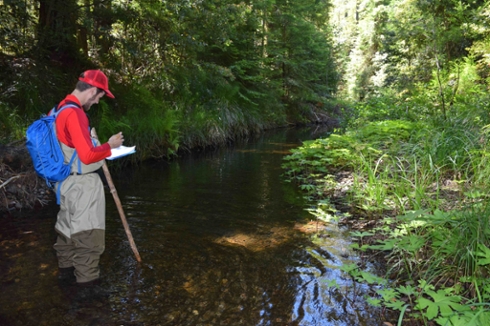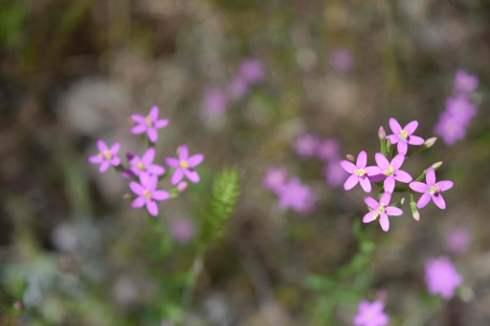Siegel Salmon Restoration Internship 2015: Garrett Linck

Garret Linck is working on habitat conservation and restoration in the California wilderness as the Paul Siegel Salmon Restoration intern. Read on for his first impressions and experiences.
Situated between Redwood groves and the Pacific Ocean, I have spent my first two weeks as the Paul Siegel Salmon Restoration Intern at the Mendocino Land Trust (MLT) traipsing through the rivers and forests of the North Coast. After a warm welcome from the crew at the MLT office in Fort Bragg, I drove over to Russian Gulch State Park and hauled my guitars, a few crates of vinyl, and my bicycle into the cabin where I will be living until August. From my doorstep, it is a brisk ten-minute walk to the Russian Gulch Headlands and Sinkhole—a mesmerizing locale where I’m frequently impressed by the force of the tide coming in and the abundance of wildlife. Nestled among the craters that perforate the cliff walls, Black Oyster Catchers cling to the walls as the strong wind ruffles their feathers.
On my second day, I jumped into Doug Kern’s (Big River Program Manager) green pickup with Nicolet (Trails & Stewardship Coordinator), and we meandered through the potholed roads of Jackson Demonstration Forest until we reach the nonsensically-named North Fork South Fork of the Noyo River. Doug and Nicolet each donned a pair of waders, which seemed to vie for the title of ‘most-waterlogged’. Doug’s quickly earned the title as evidenced by the continual fountain of water from his boots as he emerged from the river. I penciled in measurements of various habitat types as we traveled upstream, differentiating between Riffles, Scour Pools, and Non-Turbs (three different habitat classification units, denoting the depth, width, and velocity of the water). The terminology takes a bit of time to pick up on, but by the end of the day I was gaining confidence in both my understanding of the survey and my ability to scramble through thorns and underbrush. Three new pairs of waders should be arriving soon, and we will renew our efforts surveying the two-mile segment.

Though I’ve been made aware of what locals call ‘the June gloom’ (referencing the frequent overcast weather and dense fog that often envelops the shores of Mendocino County), I’ve quickly adapted to the climate here. After escaping the intense heat of Portland, I was happy to discover the coastal temperatures ranging from mid-fifties to mid-sixties—perfect for trail-work, hiking, or biking. Last weekend, I traveled North with MLT staff and a few board members to initiate trail work on a new segment of Lost Coast Trail at Shady Dell. Before we bushwhacked through old logging roads to show the board members the property, we were greeted by five beautiful Roosevelt Elk, placidly grazing alongside the road.
Looking forward, I have an ambitious number of projects that I will be involved in during my stay in California. I will be working closely with Doug on a variety of habitat monitoring and restoration projects. Currently I am focused on drafting a grant proposal to install a large number of temperature sensors within the Big River Watershed—the objective is simple; to provide temperature data before further efforts to improve the salmon habitat are undertaken. This will enable us, and other organizations conducting habitat restoration projects, to gauge the efficacy of our work on a specific parameter which is very important to Coho Salmon. While developing our habitat monitoring plan, we are preparing for various road decommissioning projects to return old logging roads to their natural state in an effort to avoid increasing sediment levels in the Big River Watershed. As the summer progresses, I’m excited to gain experience in grant writing as I work with Doug on our latest Redwood habitat restoration plan.

Tags: siegel, siegel internship, restoration, environment, conservation, nature
